Are Wheel Spacers Safe? We’ve Got The Answers
Looking to widen your ride without breaking the bank? These could provide an affordable solution. But are wheel spacers safe for drift, street, and track cars?
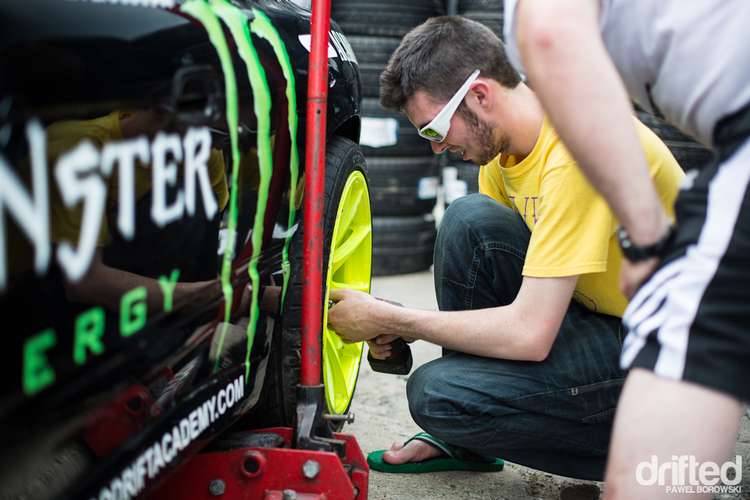
Jump To Section
Introduction
There are a few things to know if you’re planning to fit spacers into your daily driver, drift car, or off-roader, and we’ll cover them all in this guide.
We’ve gone the extra mile to do the math and weigh the pros and cons of fitting spacers to your ride.
You’ll learn things like hubs and offset and determine whether wheel spacers are safe for your needs.
First things first – what are wheel spacers? Wheel spacers, or just spacers, are machined metal that sits between the rim and the hub to which the wheel is attached.
Spacers create an offset in your wheels, but what kind of offset?
An offset can be both positive and negative. To understand offset better, take a look at the following sets of rims:
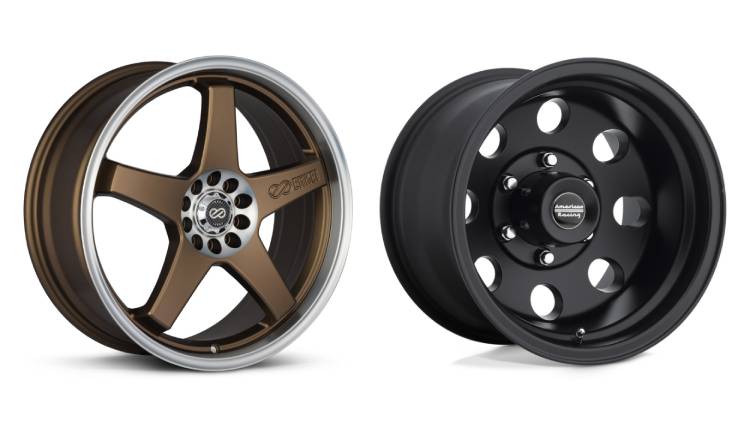
The first difference to spot here is the placement of the wheel disk, using the two examples above.
As you can see, the disk sits near the front of the wheel on the left rim. However, the one on the right has the disk pushed inside the wheel.
Here, offset is present on both wheels.
The one on the left is a rim with a positive offset, which enables the tires to sit further inside the fender, and the one on the left has a negative offset, which provides a ‘poke,’ leaving the tires sitting further out of the fender for a wide stance.
A rim in which the disk is in the center has a zero offset and is sometimes called a zero set rim. Conversely, a rim with a positive offset can be labeled an ‘inset rim,’ while a rim with a negative offset is called an outset.
Enough about rims; let’s talk more about what wheel spacers do and answer the question of are wheel spacers safe. We’ll look at the different types of spacers available on the market and how you can fit them correctly.
What Are Wheel Spacers?
We’ve already explained what wheel spacers are, but check out this spacer from MODE to provide a clearer picture.
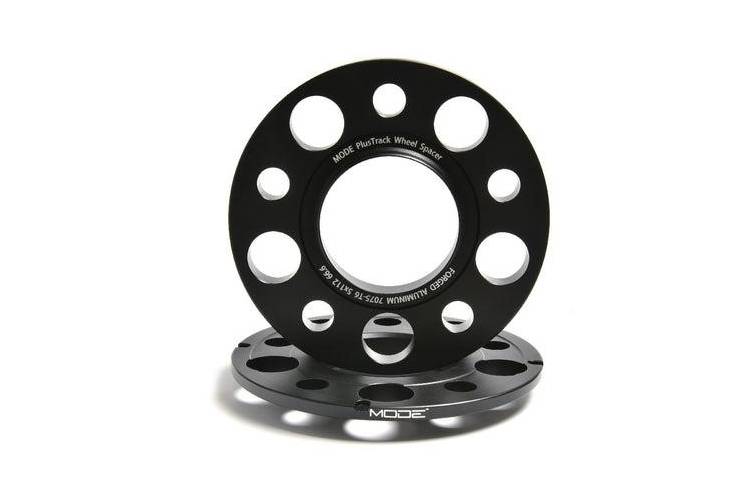
Made from 7075 aluminum with a tempered grade of T6, these are premium quality hub-centric wheel spacers. T6 is precipitation-hardened aluminum, which has undergone multiple heat treatment cycles to ensure that the spacer is strong enough to withstand its forces.
It would be best if you did not confuse wheel spacers with coilover spacers, which go between the strut mount and the chassis.
So, What Do Spacers Do?
Spacers are used in quite a few scenarios depending on your particular need.
For example, let’s say you’ve gotten rims that have an incorrect offset, leaving them too far within the fender to pull off the stanced look you’d hoped to achieve.
It’s often recommended to rectify this offset because the manufacturer has spent a lot of time calculating intricate distances. This scenario’s convenient, low-budget solution is to run spacers on your wheel hubs.
However, spacers can only correct the issue on inset rims: wheels having a positive offset.
If your new wheels are sitting too far out of your fenders, you’ll need to consider fender rolling, flaring, or opting for a wide body kit, such as the hugely popular offerings from Rocket Bunny.
Different Types of Wheel Spacers
Wheel spacers generally fall under two categories: bolt-on or slip-on.
Bolt-on Spacers
Bolt-on spacers have the spacer bolted to the wheel hub. In addition, they have separate studs for the rims to attach to for additional strengthening.
To know more about design considerations, imagine a situation where you want to fit at least more than ½ an inch wide spacer.
With this, you have a spacer that takes most of the length of your wheel studs, leaving just enough space for bolts, which we calculate to be a minimum of 12 millimeters (around 8-10 turns, depending on your pitch.)
Slip-on Spacers
As the name suggests, this spacer doesn’t involve bolting to the hub; they’re placed onto your wheel studs, and the rim rests on them. While these are the easiest way, they’re far from the best.
They are usually thinner than the more substantial bolt-on spacers because your wheel studs cannot accommodate thicker wheel spacers as the studs would be too short.
We do not recommend considering more than 25mm wheel studs (if you plan to replace them) since longer wheel studs increase the chance of snapping in half – trust us when we say that no one wants that!
Most rim designs usually have a flange in the center to ensure that the rim sits precisely in the center of the wheel hub. Wheels also have exactly the matching taper on their insides.
Hub-centric Spacers
Correct-fitting hub-centric spacers ensure that your rim fits precisely in the center of the spacer. In addition, they have tapers and flanges that match your wheels, ensuring maximum safety.
Ensure that you find the correct spacers for your wheel specifications, as some manufacturers provide different fitments.
You must ensure that the spacer sits perfectly flush with the hub, with no movement.
Any movement indicates bad fitment, which could potentially be dangerous. Avoid this at all costs.
Lug-centric spacers
Lug-centric spacers are not recommended because they might not let the wheel sit precisely in the center, and the spacer only sits on the lugs.
This might be fine if you’re within geometric tolerances, but not in any other situation.
Slip-on spacers and bolt-on spacers are both available in hub-centric designs.
Wheel spacers are available for all road vehicles. Some spacers are specifically designed for use in off-road applications.
Like the spacer shown above, these are made from 6000 or 7000-series precipitation-hardened aluminum. This makes them sturdy, and since the curb weight of your truck is more than a car; they are the way to go.
The Benefits Of Wheel Spacers
Few things in life are more thrilling for people who spend much of their time on the road, or the track, than achieving the perfect fitment.
We mentioned earlier that spacers are typically used when you want to fit a wider rim and, inevitably, wider tires.
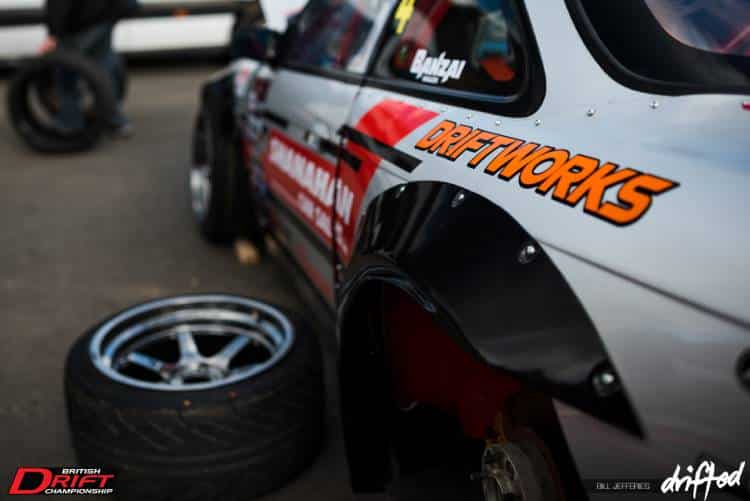
Even off-road vehicle drivers also like replacing their factory tires with bigger ones. Wheel spacers are necessary to prevent these wider/larger tires from rubbing against the wheel wells, suspension, or fenders.
Some car owners may swap the factory brakes for higher-performance ones to improve stopping power. However, these brakes are often broader than the factory ones.
Wheel spacers can also create additional room for the bigger calipers to sit without destroying your rims. Unfortunately, we’ve seen this happen with brand-new wheels, and it’s not pretty!
In this scenario, you’ll want to ensure that you still have clearance for the wheel within the fender, which often comes down to millimeter-perfect precision.
Top-quality wheel spacers will often set you back around 100 bucks brand new—even those made of aviation-grade aluminum, which has both high-quality and high strength.
Depending on who you ask, changing a car’s exterior design might be advantageous or disadvantageous. However, the unusual appearance of the wheels being flush with the fenders is appealing, as long as there is enough clearance.
Since we’re on the topic of a flush appearance, consider a Nissan 350z, a popular choice among drift enthusiasts.
We’ll use the infamous Rocket Bunny kitted Z to understand a true widebody appeal and why you may need spacers to fill out your fenders.
Installing wheel spacer adapters is as simple as changing a wheel on your ride.
We’re counting this as a huge plus factor since the installation may be completed without difficulty using only the simplest tools.
Installing Wheel Spacers
We’ll explain how simple it is to install wheel spacers to your ride. The same method applies whether it’s a drift car, a daily driver, or an offroader.
Measurements to consider before ordering parts:
- Length of your studs
- Required offset
- Hub hole count
- Taper and Pitch Circle Diameter (PCD) – You could consult your car’s manual for this or use a vernier caliper.
- Fitment clearances
How to install:
- Jack the car up and place your jack stands correctly before lowering your vehicle onto them.
- Start removing the lug nuts, keeping pressure applied on the brakes when you’re removing the nuts.
- With the lugs removed, take off the wheels.
- After you’ve removed the wheels, you’ll need to prepare the hub. First, clean off any corrosion with a wire brush to ensure a smooth fitment.
- Apply a layer of anti-seize on the hubs.
- After that, slide your wheel spacers over the existing lug nuts.
- You’ll need to apply the new bolts if you’re using a bolt-on wheel spacer.
- Finally, re-fit the wheel, fit the nuts, remove the jack stands, lower the vehicle, tighten the nuts once it’s on the ground with the brakes applied, and you’re good to go.
Are Wheel Spacers Bad?
Adding spacers means changing the offset, and this affects the scrub radius.
The scrub radius is the distance at ground level between the center of the tire contact patch and the kingpin inclination axis (KIA), which lies along the strut or control arm of the suspension.
Refer to the following diagram:
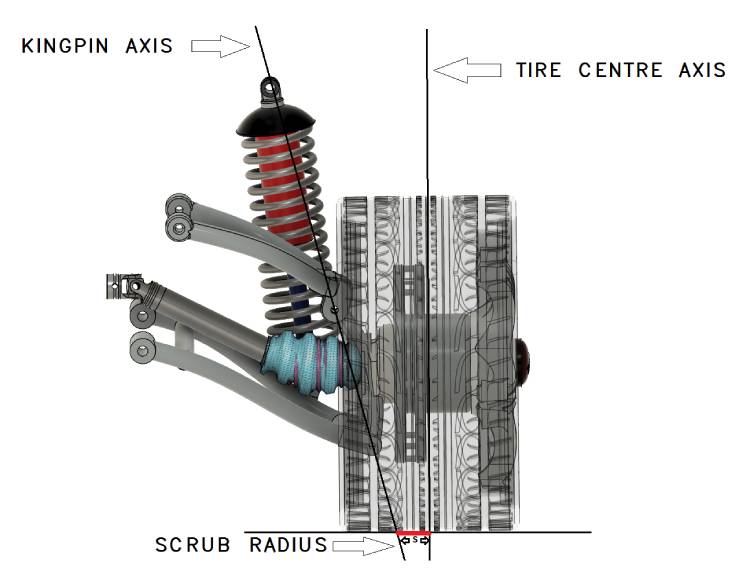
Tire wear and toe characteristics may deteriorate if you add spacers, especially when braking.
The axle’s scrub radius determines how much steering effort is required and how stable your steering is when braking. Depending on the gap between the old and new offsets, uneven front-wheel traction may cause the ride to be even bumpier from the wider track.
Manufacturers always consider the suspension’s geometry finely, but no one’s stopping you from getting a suspension upgrade!
Also, wheel spacers can cause many problems when fitted incorrectly.
Your tires can brush against the walls of your fenders, causing unnecessary tire wear, even on the insides of the walls.
Are Wheel Spacers Safe For Drifting or Racing?
Excessive lateral tire loads are applied whenever drifting, racing, or even spirited daily driving, putting wheel bearings under additional strain, which understandably leaves people questioning, “are wheel spacers safe?”
The amount of load experienced by each of the two wheel bearings connected to the strut is affected.
This is where you must not compromise on the quality and fitment of spacers since this will ultimately determine whether you’re happily drifting or stuck on the curb crying over a failed drifting attempt that’s left your wheel detached from your hub!
We at Drifted believe in providing the best advice for you to continue happily drifting while also admiring the flushed, stanced look on your ride. For this specific reason, consider the following when even thinking of running spacers:
- It is imperative to ensure you know what material your spacers are made from. And yes, we recommend a high-performance alloy with high strength. (aluminum 7000 is an alloy of aluminum with zinc, magnesium, and copper, having the highest strength of all aluminum alloys)
- Ensure that the spacers you buy are hub-centric, and we can’t stress this enough.
- A bolt-on could be a way to go for a slight increase, but it still wouldn’t be our preferred method. If you’re thinking of running longer studs, we recommend that you don’t do this, although switching to aftermarket high-performance studs could provide an alternative.
- ALWAYS torque the studs according to your wheel specs as per the manufacturer. Load distribution across the hub remains optimum.
Conclusion
To conclude, wheel spacers are safe if you buy high-quality, correct-fitting parts and fit them as intended.
They can improve the looks of your ride and make your wheel choice far more varied, alongside the benefits of improved grip from the wider track.
Frequently Asked Wheel Spacer Questions
Here are some frequently asked questions regarding fitting spacers to your vehicle.
How do I calculate the required wheel offset?
Wheel spacers change the offset by a negative factor. For example, if you have 17-inch rims at +45mm offset, you plan to run 15mm spacers; the total offset will be 30mm.
Do I need to re-torque spacers?
We recommend retorquing 100 km after initial fitment as a preventive caution. Then, check every 500 km after that or when removing your wheels. In a drift car, this can be quite often!
What about re-torquing bolt-on spacers?
When using bolt-on wheel spacers, you must re-torque ALL bolts, including the bolts holding the spacers.
Do I need an alignment after installing spacers?
It is recommended if you’re looking for optimal handling, especially if you’ve only fitted them at the front or rear. But, of course, an all-around setup will keep things equal so we wouldn’t be too concerned.
Is it possible to double up wheel spacers?
You can only do this when using slip-on spacers, and it’s not recommended. If you ignore this advice, ensure that you leave at least 10mm on the studs to tighten the lug nuts properly.
Can bolt-on spacers work as adapters?
Yes. Bolt-on spacers come in dual bolt pattern designs known as wheel adapters, which allow you to fit, for example, a 4-hole rim to a 5-hole wheel hub.
Is it okay to install spacers on trucks?
Yes, but you’d want premium-quality ones like what Eibach and BORA offer. The same also applies to the likes of SUVs.
Are wheel spacers safe for drift cars?
The same situation applies, despite the additional load you can expect from a drift car. This just means that it’s even more important than ever to ensure you opt for high-quality parts, and make sure that they’re fitted correctly to your vehicle.


 (3 votes, average: 3.67 out of 5)
(3 votes, average: 3.67 out of 5)




















